Understanding your horse – Part 02
|
|
Ihr Pferd verstehen – Teil 02
|
Awareness of signals sent
Our last conversation example:
- In the last Blog I told you about a conversation between my horses and myself, into which we must now fill in the (…..) blanks. It began with me saying “Riding?” and King replied: (head moving sideways away from me, weight backward, touching Beau’s flank with nose with quick ear flattening, then moving parallel to him). When I agreed with him, Beau said (nose forward with lengthened neck, ears pricked, nostrils open), which triggered King to say (ears forward, one step forward, touching Beau’s belly, quickly dropped ears, blinking eyes) then, while Beau was saying (head to King, ears flattened) King (moving away sideways one step, flattened ears, head sideways and away) Beau continued (ears pricked, step forward, parallel to King), and off we went to play. I probably missed more than half the signals, but those were the most obvious ones. If you don’t understand this conversation, look up the translation into words in the last Blog – and soon we also get into the entire vocabulary!
|
|
Erkennen der gesendeten Signale
Unsere letzte Unterhaltung:
- Im letzten Blog habe ich Ihnen eine Unterhaltung wiedergegeben, in welcher wir nun die (…..) Lücken füllen müssen. Es begann damit, daß ich King fragte „reiten?“, worauf er antwortete: (Kopf seitwärts von mir abgewendet, Gewichtsverlagerung rückwärts, kurze Bewrührung von Beaus Flanke mit der Nase, schnelles Ohrenanlegen, paralleles Aufstellen). Als ich ihm zustimmte, sagte Beau (Nase mit langem Hals vor, gespitzte Ohren, offene Nüstern), woraufhin King sagte (Ohren vor, einen Schritt vor, Nasenberührung an Beaus Bauch, schnelles Ohrenabklappen, Blinzeln) und dann, als Beau sagte (Kopf mit angelegten Ohren zu King) sagte King weiter (einen Schritt zur Seite, angelegte Ohren, Kopg seitlich weg), woraufhin Beau sagte (Ohren nach vorn gespitzt, Schritt vor und parallel mit King) – und ab gings zum Spielen. Ich habe vermutlich die Hälfte der signale übersehen, aber dies waren die offensichtlichsten. Wenn Sie das nicht verstehen, schauen Sie im letzten Blog die übersetzung nach – und jetzt kommen ja auch bald die einzelnen Vokabeln!
|
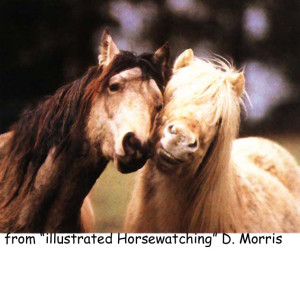 This body language is easily translated – every part expresses friendship: ears, eyes, nostrils, mouth and posture.
Diese Körpersprache ist leicht zu übersezten – alles drückt Freundschaft aus: Ohren, Augen, Nüstern, Maul und Haltung.
|
Learning to see the signals:
- So in the last part we already became aware of the fact that horse communication via body language is quite a complex topic, because it consists of usually very soft, almost invisible signals, which happen very quickly and also not one by one: the signals are combined and depending on the combination the individual parts can change meaning as well.
Start the fascinating exploration!
- If you disagree with me that is totally fine too. I am not afraid of being subjective or not too scientific here, although a lot of reading of whatever there is to be found in terms of behavioural science about horses was certainly my homework for these Blogs! What I want to do is start you on a fascinating exploration deeper into the world in which your horse lives – and though the information, which I can give you, might be incomplete, or you might disagree with it totally – it will still get you into “seeing” your horse better and improving your relationship with him. That alone is enough for me!
|
|
Das Sehen der Signale lernen:
- Schon im letzten Teil also ist uns bewußt geworden, daß die Kommunikation der Pferde mit Körpersprache ein ziemlich komplexes Thema ist, da sie normalerweise aus vielen sanften, fast unsichtbaren Signalen besteht, die blitzschnell und kombiniert gesendet werden, wobei die jeweiligen Kombinationen die Bedeutung auch noch verändern können.
Wir starten die faszinierende Untersuchung:
- Wenn Sie hierin mit mir nicht übereinstimmen, ist das total in Ordnung. Ich habe keine Angst davor als subjektiv oder nicht wissenschaftlich genug zu gelten, obwohl ich wochenlang alles, was ich zu diesem Thema an Verhaltenswissenschaft finden konnte, als Hausaufgaben für diese Blogs nachgelesen habe! Ich möchte Sie ja nur auf den Weg einer faszinierenden Untersuchung tiefer in die Welt Ihres Pferdes bringen – und obwohl die Informationen lückenhaft sein oder Sie damit gar nicht übereinstimmen mögen, so wird es Sie dennoch dazu bringen, Ihr Pferd besser zu „sehen“ und Ihre Beziehung zu verbessern. Das genügt mir!
|
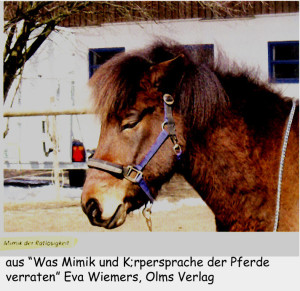 This horse is not sleeping – he is an unhappy picture of being at a total loss – he symbolically withdraws from a depressing situation.
Dieses Pferd schläft nicht – es ist ein Bild der Ratlosigkeit – symbolisch zeigt es ein Sich-Zurückziehen von einer deprimierenden Situation. |
Another example, for why this is necessary:
- Yesterday I watched two women practising some recently learned “natural horsemanship”, which was obviously news to their horse. They started by backing the horse up, wildly shaking the rope in front of his face. (Backing up seems such a good idea for getting your horse “under control” and showing him who is the alpha?) The horse showed stress, unhappy ears back and down, frantically blinking eyes or ripped wide open, when the rope came flying to close, brief lip-licking and tongue showing, signs that he was at a complete loss. For half an hour he was saying “Please don’t do anything to me, I don’t know what you want, but I am very much trying to avoid conflict!” His women missed it all! They didn’t even once look at what their horse was saying, because they were so busy with themselves… he did not once relax and have a content expression. THAT is not horsemanship!
|
|
Noch ein Beispiel für die Notwendigkeit:
- Gestern habe ich zwei Frauen dabei zugeschaut, wie sie gerade gelernte “natural horsemanship” übten, was für ihr Pferd offensichtlich neu war. Sie fingen gleich mit Rückwärtsrichten an, indem sie wild das Seil in sein Gesicht schüttelten. (Rückwärts ist ja immer so gut, um das Pferd „unter Kontrolle“ zu bringen und ihm zu zeigen, wer der Alpha ist?) Das Pferd zeigte Streß, unglückliche Ohren nach hinten unten, dauerndes Blinzeln oder weit aufgerissene Augen, wenn das Seil allzu nahe kam, kurzes Lippenlecken und Zungezeigen, ein Zeichen der Ratlosigkeit. Eine halbe Stunde lang sagte es „Bitte tut mir nichts, ich weiß nicht was ihr wollt, aber ich bemühe mich sehr, einen Konflikt zu vermeiden!“ Seinen Frauchen entging das alles! Sie schauten nicht einmal auf sein Gesicht, da sie mit sich selbst so beschäftigt waren… das Pferd entspannte sich nie und sah nie zufrieden aus. DAS ist kein Horsemanship!
|
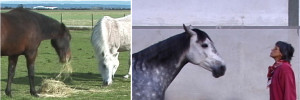 The frontal stare is a request for yielding, which is understood by all horses, as they have learned it in the herd – we need not swing ropes in their faces!
Frontales Anstarren ist ein Signal zum Weichen, das jedes Pferd versteht, da es das in der Herde gelernt hat – wir müssen keine Seile in ihr Gesicht schleudern!
|
Again: the human lead-mare:
- Natural Horsemanship, as I mention before, is all about becoming your horse’s “Lead-mare” – they all tell you that, don’t they? Well, a thoughtful person would instantly recognize the gap between what we say and what we are taught to do – because, very obviously, a lead-mare never shakes a rope in front of another horse’s face to back him up!!! So, again obviously, the shaking of the rope is a signal, which is NOT embedded in the horse’s genes (whereas a frontal stare of the eyes, which demands the same yield, IS) and therefore must be understood, learned by the horse, before you can demand obedience to it! Demanding obedience to an unknown signal, (the meaning of which the horse didn’t have a chance to learn yet) is very unfair – it is an assault, which triggers confusion – and loss of trust.
- So for fairness’ sake alone, we must learn to listen to our partners better – and adjust and clarify our training, in order to make the learning experience a positive and happy one for all.
|
|
Wiederum: die menschliche Leitstute:
- Wie früher schon erwähnt dreht sich im Natural Horsemanship alles darum, die Leitstute Ihres Pferdes zu werden – das wird Ihnen doch immer erklärt, nicht wahr? Da müßte nun eine nachdenkliche Person sofort die Lücke bemerken, die besteht zwischen dem, was wir sagen und dem was wir tun sollen – denn offensichtlich wedelt eine Leitstute ja niemals ein Seil vor einem anderen Pferd, um es zum Weichen zu bringen!!! So ist es klar, daß das Schütteln des Seils ein Signal ist, welches NICHT in den Genen des Pferdes verankert ist (während ein frontales Anstarren, das eine Aufforderung für dasselbe Weichen ist, es IST), und welches daher vom Pferd verstanden und gelernt werden muß, bevor man Gehorsam darauf verlangen kann! Gehorsam verlangen auf ein unbekanntes Signal (das das Pferd noch nicht lernen konnte) ist sehr unfair – das Signal ist dann ein Überfall, welcher Verwirrung und Vertrauensverlust bewirkt.
- Also schon um der Fairness willen müssen wir unseren Partnern besser zuhören – und unser Training dementsprechend anpassen und klarer machen, damit die Lernerfahrung positive und glücklich für alle sein kann.
|
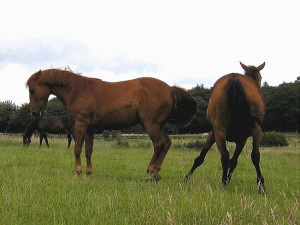 Here the situation has escalated already and the signal is clear – the bunched up rear promises a good kick and the other horse clears out!
Hier ist die Situation schon eskaliert und das Signal ist deutlich – das angespannte Hinterteil verspricht einen kräftigen Tritt und der andere macht sich aus dem Staub. |
The escalation is never happy:
- I mentioned before that it is relatively easy to “see” the end of a conversation, the escalation, and therefore the most powerful signals which a horse will send. The cocked hoof or the bunched up body, ready to lash out, a signs that will not be ignored!
- A stretched out neck with flattened ears and bared teeth in your direction would be a clear signal to anyone with or without deeper knowledge about horses to speedily retreat – end of the conversation! We recognize the “display behaviour” of a male animal trying to impress a female, and hopefully we all recognize extreme nervousness or fear with body in flight posture, sweating or even diarrhoea.
|
|
Die Eskalation ist nie glücklich:
- Wie schon erwähnt ist es relativ leicht, das Ende der Auseinandersetzung zu „sehen“, die Eskalation mit den stärksten Signalen, die das Pferd senden wird. Der angewinkelte Huf oder der zum Ausschlagen geballte Körper sind Zeichen, die nicht leicht ignoriert werden!
- Auch ein vorgestreckter Kopf mit angelegten Ohren und gebleckten Zähnen in Ihre Richtung wäre ein klares Signal auch für Leute ohne Pferdebildung, daß es Zeit für den Rückzug ist – Ende der Unterhaltung! Wir erkennen auch meistens das Imponiergehabe eines männlichen Tieres, um einem weiblichen Eindruck zu machen, und hoffentlich erkennen wir auch extreme Nervosität oder Angst mit Körper in Fluchthaltung, Schwitzen oder sogar Durchfall.
|
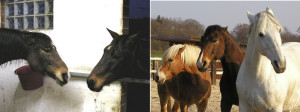 Ears on the left say: “Stay clear of my bucket!” – but what do the three horses on the right say to each other??
Die Ohren links sagen “Bleib weg von meinem Eimer!” – aber was sagen die drei Pferde rechts zueinander?? |
The soft signals:
- But the main conversations, which happen in front of my eyes every day and most of the time do not lead to an escalation, happen very rapidly with a mix of so many signals that I have given up trying to catch them on photographs! The camera doesn’t even click fast enough.
- So if you have interesting photographs (other than just the hello-faces into the camera) send them to me! At the very least I could use them for explanatory drawings. Thank you!
- Next time we will start with what the horse says with his whole body – then we will go into smaller details.
Read on! |
|
Die sanften Signale:
- Aber die Hauptunterhaltungen, die jeden Tag vor meinen Augen ablaufen, führen ja nicht zu Eskalationen. Sie laufen so schnell und mit einer Mischung von so vielen Signalen ab, daß ich es aufgegeben habe zu versuchen, sie mit der Kamera zu erwischen – meine löst gar nicht schnell genug aus!
- Sollten Sie also interessante Fotos haben (nicht nur Hallo Gesichter in die Kamera) dann schicken Sie mir welche! Ich könnte sie zumindest für erklärende Zeichnungen gebrauchen. Danke!
- Nächstes Mal werden wir damit anfangen zu betrachten, was das Pferd mit seinem ganzen Körper ausdrückt – dann werden wir weiter ins Detail gehen.
Lesen Sie weiter! |